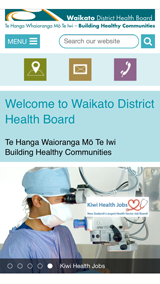Waikato District Health Board
by Room9
The Waikato District Health Board is one of the first government agencies to take advantage of the Common Web Platform (CWP). We were approached and selected to develop a full re-build of the Waikato DHB's website on the CWP.
The main challenges of the development of this responsive and highly visited website was firstly the fact that we had to be pioneers on a new platform (launched the month before our work started) and secondly to make sure the website supports IE7 and IE8.

Featured
Sept, 2014

The website is a major communication and recruitment tool for a District Health Board that has the duty of caring for 373,220 people, of whom 60% live outside the main urban areas.
The Waikato DHB needs to be able to compete for talent in New Zealand and overseas.
As Mary Anne Gill, Communications Director, explains, the “Waikato DHB is recruiting in a global market for intelligent and passionate health professionals. Our website has to look professional and be secure reflecting our reputation of being a health provider entrusted with your loved ones' care.”
Towards the end of 2013, the Waikato DHB’s website was based on old technology. It was built on a proprietary platform, which made it expensive and painful to modify and to maintain. It had experienced security issues. Finally, it was no longer able to cater for the needs of the DHB, which had shifted since it had been built. The Waikato DHB decided it was time for a change.
Having had to suffer through two extensively publicised hacking incidents - with the consequent damage to its reputation and subsequent additional costs - security was one of the top requirements for the new web infrastructure. To this regard, CWP provided a holistic solution covering security, backup, and disaster recovery. Penetration testing, infrastructure hardening, multi-tier security, and audits are all included as part of the platform.
The Waikato DHB decided to use an approach in which the information architecture and design were done in-house, the development done by a technology partner - Room9, and “going-live” was not considered the end of the project but the start of an ongoing evolution.
Waikato DHB held focus groups with external stakeholders (including groups with senior users, students, and with users from rural communities) in order to provide insights about the features and the content that they wanted on the DHBʼs website. In-depth interviews were held with internal stakeholders for a similar purpose. All of the insights uncovered by the user research phase were contrasted against the information provided by the web analytics applications, against the already existing functionality and content, and against a wide set of web technology and design global trends.
It was clear that 20% of the website traffic was already coming from mobile devices, so the incorporation of a responsive front-end framework plus the implementation of small-canvas designs ensured that mobile visitors got an exceptional user experience. The DHBʼs website was designed with four break-points which provided layouts for large desktops, small desktops, tablets and mobiles.
On the other hand, the website's ability to support Internet Explorer versions 7 and 8 was an important requirement as 30% of all visitors used these legacy browsers.
The teams at Waikato DHB and Room9 engaged in an iterative development process using the designs as a starting point to quickly prototype and develop the website using the foundation provided by CWP. Thanks to the hosting, deployment and supporting infrastructure built into CWP, the teams could focus primarily on development and content delivery during the project. New versions were released for testing in a matter of days and even hours and productivity remained high.
From start to end the whole re-built happened in under three months. In the time since, Waikato DHB has continued to evolve, refine, and grow their website, all the while earning accolades and positive feedback from its stakeholders.
It enabled the success of initiatives such as free public Wi-Fi at the Meade Medical Centre as the users land on a highly optimised landing page that shows the information and services most required by outpatients. This is already the most visited page of the website and has received many shows of appreciation from grateful patients who are delighted of having the exact things they need right on their mobile devices.
This success would not have been possible without having the right technology - SilverStripe - in place and also without having the right people - the teams at Waikato DHB and at Room9 - driving and executing the project.
Launched
- 10 February 2014
Other projects

The Lunchbox Club
by Room9
